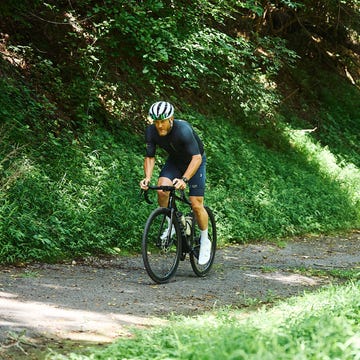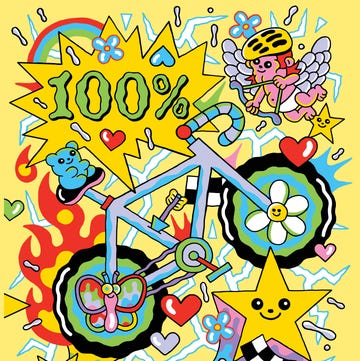It was 1996, and the movie Space Jam, starring Warner Bros.’ Bugs Bunny and Chicago Bulls star Michael Jordan, had just been released. But more important to me, it featured the female counterpart to Bugs, Lola Bunny, a talented and skilled basketball player in the Tune Squad. As a 9-year-old sitting on the bleachers at my brothers’ basketball practices, I wondered: Why couldn’t I be on the court too? After begging my mom, my sister and I joined the league as the only girls on the newly formed co-ed team.
With my long hair tied up with a colorful floral scrunchie and my bangs puffed up (a mix of styling and a result of Puerto Rican humidity), I hit the court in a lime green team T-shirt, volleyball shorts, and whatever sneakers I had at the time. That first weekday evening game, I remember feeling a little lost after the referee blew the whistle and squeaking rubber echoed off the polished concrete. But within seconds, I was running up and down the court. Every time the ball was passed to me, I had to remind myself to dribble as the coaches and parents shouted a chorus of instructions from the sidelines. After receiving one pass, I heard someone shout, “Shoot!” So, from the five o’clock position in the arch, I stretched my gangly frame just like I’d seen players do on TV and went for it… Believe it or not, I scored.
I didn’t score again the rest of the game, and I didn’t stick with basketball, either. Dad thought it wasn’t “feminine” enough—though today, my now-enlightened father would cringe at that notion.
A year after my brief stint with basketball, the Women’s National Basketball Association (WNBA) was born following the rise and popularity of NCAA women’s basketball. Players like Sheryl Swoopes, Lisa Leslie, and Cynthia Cooper led the charge, carving out a space for women in professional basketball and inspiring young athletes all over the country.
But no previous generation of female basketball players gained so much popularity as the one on the courts today. The standout figures of this cohort bear the names of Angel Reese, A’ja Wilson, and Caitlin Clark, among many others, players whose electric energy and unapologetic confidence have made them a force both on and off the court. Reese, often celebrated for her boldness, has embraced her role as a cultural icon. From her viral “You can’t see me” taunt to her advocacy for player empowerment, she represents a generation unafraid to challenge norms and speak out. Wilson has emerged as a central figure due to her dominance with the Las Vegas Aces as well as for her openness about mental health and her advocacy for social justice, ensuring her influence extends beyond the court. While Clark’s personal style is more subdued, she isn’t only about the stats; she captivates audiences with her fierce presence and bold style of play. This new generation of athletes underscores the powerful role of personality in sports, influencing the future of women’s sports by embracing individuality and fearlessness.
The rise of players like Reese and Wilson, and the “Caitlin Clark” effect, show a broader trend in women’s sports: increased visibility. Clark’s record-breaking rookie season not only boosted WNBA regular season and playoff viewership, but also led to the league’s highest total attendance in 22 years. This surge in demand helped justify a $2.2 billion media rights deal, fueling league expansion into new markets like Golden State, Toronto, and Portland—further highlighting what’s possible when athlete personalities are given the spotlight.
This same potential for bold personalities exists in women’s cycling, too. It lives in the tension between Lotte Kopecky and Demi Vollering, whose fierce rivalry and contrasting styles ignite dynamic storytelling. It’s in the energetic interviews of Cecilie Uttrup Ludwig, who rides with spirited unpredictability. It lives in Pauline Ferrand-Prévot, with her multidiscipline mastery that has earned her more World Championship titles than any man. It’s in Alison Jackson, who has already broken into the influencer space through her humor and playful dance routines—and may be the best example of what I’m talking about.
However, fan support doesn’t materialize overnight. As seen in women’s basketball, and women’s soccer before it, building long-term engagement is crucial. Visibility isn’t enough—women’s pro cycling must foster a community that will feel invested in the sport for years to come.
In women’s cycling, there’s a unique opportunity to learn from this momentum and carve out its own identity beyond marquee events like the Tour de France Femmes by embracing individuality and personal brands. Just as WNBA players use the tunnel walk to showcase their style and connect with fans beyond the court, cyclists can lean into their own identities to stand out. What’s clear is that the sport needs a breakout star—someone with the charisma and boldness to make its value universally recognized. Cycling’s Wilson or Clark could come from the deep pool of talent in the Women’s WorldTour, but if PR teams, sponsors, and the broader media want to fully capitalize on this potential and build deeper connections with audiences, they must amplify these personalities through social media and brand partnerships.
I live for the day when the women in the pro peloton feel emboldened enough to be unapologetic during interviews, confidently expressing their opinions, personalities, and passions without fear of judgment or the need to conform to traditional expectations. Just as Lola Bunny made me believe I could trade the bleachers for the basketball court, the next wave of cycling stars could inspire young fans to leave the sidelines and own their boldness on and off the bike. While cycling may not have found its breakout personality yet, I’m certain she’s out there—waiting for her moment. If the sport nurtures authenticity and allows athletes to express who they are, the next great cycling personality might surprise us all.













